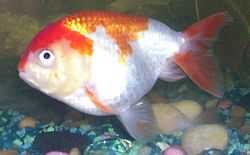Lionhead (goldfish)
| Lionhead |
|---|
 |
| Country of origin |
| China |
| Type |
| Fantailed |
| Breed standards |
| BAS |
The lionhead has a hooded variety of fancy goldfish. This fish is the precursor to the ranchu.[1]
Description
The tremendous hood or headgrowth and fat cheeks of lionheads give them a facial appearance similar to canine puppies.[2] The "wen" (Chinese term for headgrowth) fully covers the head, cheeks and gill plates of the fish.[1][3] Furthermore, lionheads have short but deep bodies, and relatively straight[2] or evenly arched backs without dorsal fins. The finnage, in general, is short. Breeding standards require that the lionhead’s anal fins are paired, the double tail fin should not droop, and its upper edges should be held away from the body.[4] The tail of a traditional lionhead can be fully separated, partially separated, or webbed. The tail should also meet the caudal peduncle (the area where the body joins the tail) in a fashion that is almost perpendicular to the body.[1][3] The caudal peduncle is ideally broad, allowing the tail to open when the fish swims. The back of the proper lionhead is quite broad to support the placement of the raspberry-like hood.[3] Hood development may vary but is more pronounced in males. The hood normally takes a year to develop in young fry. Mature male lionheads periodically shed patches of their headgrowths.[4]
Lionheads can grow up to 6 inches (15 cm) in length (including finnage) and may have metallic, nacreous or matte scales.[4] They are available in orange, red, white, red-and-white, blue, black, black-and-white, black-and-red, natural, and chocolate coloration.
Origins

Lionheads were bred in China to depict the image of the mythical Chinese lion-dog (the shishi, in Japanese legend).[2] They were introduced to Japan from China during the 17th and 18th centuries. The Japanese produced lionheads with more rounded back profiles, modified tails and diminished size of the headgrowth.[3]
Special care
Lionheads are sometimes sensitive to low water temperatures. Due to their slow nature, they should not be kept with faster moving fish such as comets, common goldfish, and shubunkins. If kept in an aquarium, the recommended tank size for one fish is 20 gallons with double filtration. They are social fish so tank mates are recommended. They should be kept in a species-only tank with other goldfish. It is advised to feed goldfish only sinking food because flakes can cause swim bladder issues. Lionhead goldfish are omnivores so they thrive on a diet rich in plant and animal matter. High-protein diets will make their colors more vibrant and will cause greater growth.[4]
References
- ↑ 1.0 1.1 1.2 "GFSA - Ask the Judges", an article about the Lionchu by Larry Christensen, Peter Ponzio and Scott Taylor, from the Goldfish Pages Website (Goldfish Society of America), date retrieved: 27 May 2007
- ↑ 2.0 2.1 2.2 "Fancy Goldfish: A Complete Guide to Care and Collecting" by Dr. Erik L. Johnson, D.V.M. and Richard E. Hess, Weatherhill, Shambala Publications, Inc., 2006. - ISBN 0-8348-0448-4
- ↑ 3.0 3.1 3.2 3.3 "What is a Lionchu?" by Peter Ponzio, an article from the Goldfish Pages Website (Goldfish Society of America), date retrieved: 26 May 2007
- ↑ 4.0 4.1 4.2 4.3 "An Interpet Guide to Fancy Goldfish" by Dr. Chris Andrews, Interpet Publishing, 2002. - ISBN 1-902389-64-6
See also
| |||||